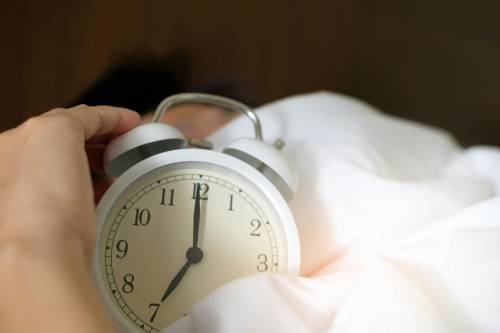

Almost everyone looks forward to springtime. However, I don’t think anyone is excited to lose an hour of sleep when the clocks spring forward.
As you may know, daylight savings time kicks off in the spring so that the clocks will be turned ahead one hour. You might not think that’s a big deal. However, losing one hour of sleep can negatively impact productivity, concentration, and both mental and physical health.
Even worse? There is an association between daylight saving time transition and short-term risk of heart attacks, strokes, traffic accidents, emergency room visits, and serious mood disorders.
Due to daylight saving time, you experience these problems because your normal exposure to daylight is altered. The change can affect your body’s circadian rhythm, which controls sleep and other biological processes. If you prepare for the time change in advance, though, it will have less impact on your sleep and overall wellness.
Keeping that in mind, here are some tips to help you “spring forward” smoothly and sleep better all year long.
Preparing for the Start of Daylight Saving Time
Since daylight saving time occurs at a set time every year, you can prepare ahead of time to prevent health problems. For example, the weekend of the time change is an ideal time to improve your sleep habits and establish good sleep habits for the long term.
Gradual adjustment.
During the week leading up to the time change in March, you can gradually adjust your schedule. According to the American Academy of Sleep Medicine, you should gradually adjust your schedule by going to bed 15-20 minutes earlier every day.
In addition to meals and exercise, other daily activities can be adjusted gradually forward as well. It is easier to acclimate to daylight saving time when you make these changes incrementally over the week before the time change.
Prioritize sleep.
Prior to the time change, make sure you get enough sleep. In case you’re wondering, that’s 7-8 hours for most adults. With this buffer, you will be able to cope with the disruption caused by the loss of an hour.
Set your clocks before bed.
Before going to bed, set your watch and clocks to the new time, even though the time change officially occurs at 2 a.m. This will allow you to start the day on the right foot and ensure that you will not be late for anything on Sunday.
Most cell phones and other electronic devices automatically update to daylight savings time overnight. In any case, update your devices’ clocks before bed if they aren’t set to do so automatically.
Be prepared for sleep disruptions.
Changing to daylight saving time can cause sleep problems, but you can minimize the chances by preparing for it. Even so, if you experience sleep problems, taking precautionary measures is wise.
In case of daytime sleepiness, don’t overload your schedule after the time shift on Sunday or Monday. You may want to schedule important meetings later in the week once you have had more time to adjust. Due to the potential dangers of drowsy driving, long drives should also be avoided right after the time change.
Easing into the New Schedule
- Don’t give in to the urge to sleep in. Sleeping in can throw off your newly established sleep schedule, even if it is tempting. Regardless of how tired you feel, try to wake up simultaneously every day. As a result, your body’s natural sleep-wake cycle is regulated.
- Take a sleep break. After the DST changes, you may feel sleepy, so take a short nap in the afternoon, but not too close to bedtime. In a few days, your internal clock should adjust.
- Relaxation techniques. Creating a relaxing bedtime routine can signal your body that it is time to wind down. Take a warm bath, read a book, practice light stretches, or listen to calming music. Sleeping is more difficult when you watch TV, work on a computer, or use your phone in bed, as these activities can stimulate the brain and prevent you from falling asleep.
Harness the Power of Sunlight
- Exposure to morning light. It would be best to expose yourself to natural sunlight as soon as you wake up. Natural sunlight helps regulate your body’s circadian rhythm, which is crucial for sleep regulation. Try going outside, opening the curtains, or sitting in front of a sunny window. Even a brief exposure can significantly improve your sleep patterns.
- At night, dim the lights. In contrast, avoid bright lights, especially screens, before going to bed. Electronic devices emit blue light, suppressing melatonin production, a hormone essential for sleep. You should dim the lights in your bedroom, turn off electronic devices at least an hour before sleep, and use blue light filters on your screens if necessary.
- Enjoy the longer evenings. There’s more sunlight in the evenings following daylight saving time. So, take advantage of that by going for a walk after dinner or keeping the curtains open.
Adopt Healthy Sleep Habits Throughout the Year
In addition to improving your sleep habits, you can also use DST throughout the year.
It’s important to stay consistent.
Be consistent with your sleep schedule, even on weekends. You’ll sleep deeper and more restfully by anticipating bedtime and wake-up times.
Create a sleeping sanctuary.
Blackout curtains, sleep shades, earplugs, white-noise machines, or all four may help. It is also important to keep the temperature between 60 and 65 degrees and have a comfortable mattress. Keep restless or snoring pets and all electronics, such as the TV and phone, out of your room. Your bedroom should be a place for sleep, sex, and relaxation.
Keep stimulants to a minimum.
Before going to bed, stay away from caffeine and alcohol. These substances can impact sleep quality, resulting in difficulty falling asleep and staying asleep.
Practicing mindful eating.
Too much food in your stomach or indigestion from spicy or fatty foods can cause insomnia. Eating light, simple foods several hours before bed will help you sleep better. When you feel hungry, have a snack that is easy to digest, such as carbohydrates or dairy. Drinking too much liquid before bed will keep you awake since you must go to the bathroom.
Exercise regularly.
Take part in regular physical activity, but avoid exercise too close to bedtime as it can be stimulating. Most days of the week, try to exercise moderately, such as brisk walking or swimming.
Avoid lying awake.
Do not watch the clock if you can’t fall asleep or if you wake up and can’t fall back asleep. This only increases anxiety. Whenever you are awake longer than 20 minutes, get up and go to another room to relax. Try to keep the lights low, drink warm milk, read a book, or write until your eyelids get heavy.
Take control of your stress.
Stress can have a significant impact on sleep. Spend time in nature, meditating, breathing deeply, or practicing yoga to manage stress. Managing stress can contribute to better sleep quality and overall well-being.
Do not use sleep aids.
It is possible that taking melatonin at night could make you sleepy during the daytime. You may also become less alert if you take prescription sleeping pills. It is also possible for some to become addicted. Before taking any sleep aid, consult your doctor to learn about possible side effects and whether it interacts with other medications.
Get professional help if you need it.
If you experience persistent sleep problems despite implementing these tips, you should consult a healthcare professional. They can identify underlying sleep disorders and recommend appropriate treatment options.
Bonus Tips
- Track your sleep. Sleep trackers and apps can be used to monitor your sleep patterns. By tracking your progress towards better sleep, you can identify areas for improvement.
- Create a sleep-wake log. You should keep a sleep diary to keep track of your sleep schedule, your caffeine and alcohol intake, and any sleep disturbances you experience. This information can be valuable in identifying potential triggers and developing better sleep habits.
- Mindfulness practices. Make mindfulness a part of your daily routine by practicing deep breathing or meditation. In addition to helping manage stress and anxiety, these practices can improve sleep quality.
In order to maintain a healthy and happy lifestyle, sleep is essential. Sleeping better on daylight saves time and throughout the year. is made easier by implementing these tips and developing healthy sleep habits.
FAQs
What is Daylight Saving Time (DST)?
Daylight Saving Time (DST) occurs during the summer months when the clock is adjusted forward one hour. Due to this, people are more likely to be awake and active in the evening when sunrise happens earlier and sunset happens later than usual.
When does Daylight Saving Time start and end?
DST in the United States begins at 2:00 a.m. every second Sunday of March and ends on the first Sunday of November. As a result, you set your clocks forward one hour in the spring and back one hour in the fall.
Do all states in the United States observe DST?
Some states do not observe DST. Daylight Saving Time is not observed in Arizona (except in the Navajo Nation) or Hawaii.
Why do we have Daylight Saving Time?
As part of the wartime effort to conserve energy, DST was created. There was a theory that more daylight hours would reduce the use of artificial lighting in the evenings. Despite this, the effectiveness of DST in saving energy is still debated.
What are the pros and cons of Daylight Saving Time?
Pros:
- There may be a slight energy savings (debated).
- During the evening, daylight hours are extended, which some people find beneficial.
- Tourism and recreational activities can be boosted.
Cons:
- Sleep patterns can be disrupted, and temporary sleep deprivation can occur.
- After the time change, there may be an increase in traffic accidents.
- Cross-time zone operations can be disruptive for individuals and businesses.
Image Credit: Acharaporn Kamornboonyarush; Pexels











Deanna Ritchie
Editor-in-Chief at Calendar. Former Editor-in-Chief and writer at Startup Grind. Freelance editor at Entrepreneur.com. Deanna loves to help build startups, and guide them to discover the business value of their online content and social media marketing.